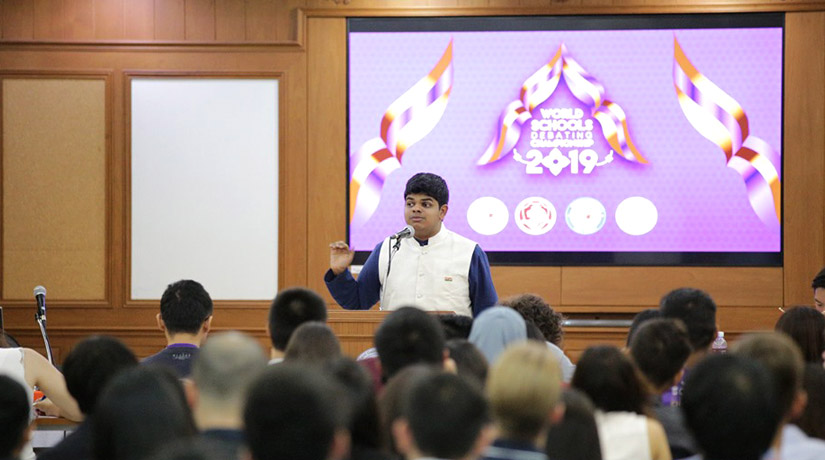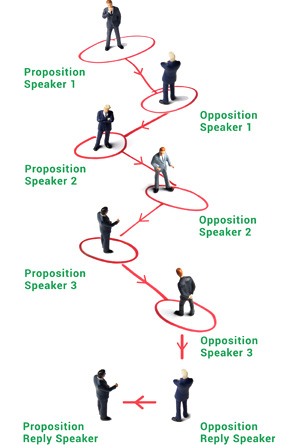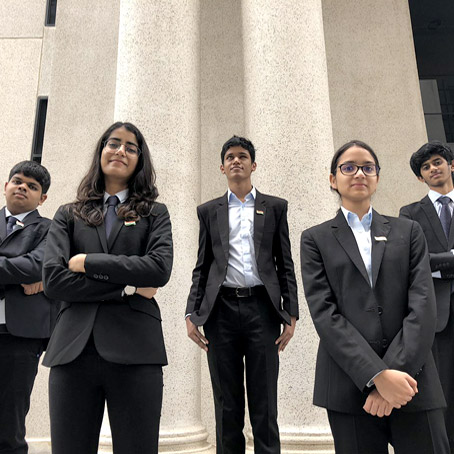The WSDC Format

Overview
About WSDC
Every year, the best young minds from over fifty countries meet to debate and discuss issues around the world. WSDC takes place every year in a different country, hosted by a national debating body. This tournament gives students unique exposure to different cultures around the world, and encourages them to create networks that last them forever. National teams engage in healthy competition for the championship, and along the way, learn to engage in constructive thought and speech, which act as tools of persuasion in their future.
The Format
A debate in the WSDC format has two teams of 3 speakers facing each other, the Proposition and the Opposition. Each speaker speaks for 8 minutes. From the 2nd to 7th minute of each speech, the speaker will also be open to questions or statements from the opposite team known as ‘Points of information’. At the end of the 6 speeches, each team will also have the option to deliver a 4-minute summary known as a reply speech.
The flow of the debate is illustrated here.

Why WSDC
What makes the WSDC format special?
From the get-go, the format challenges students and makes them better speakers and thinkers. In ‘impromptu’ debates, students are given only an hour’s preparation time from when the topic is announced. During this hour, they cannot access the internet, or any written material, or their coaches. Their only resources are themselves and their teammates.
It requires students to be efficient with their time and quick on their feet to prepare an entire case within an hour.
Students also learn to work together as a team, while also work independently, designating tasks among themselves within the given hour to deliver the best arguments possible.
It requires vast amounts of knowledge to be able to make multiple arguments with relevant examples without the use of any written material or the internet. With topics ranging from specific policies implemented by governments to broad philosophical debates, students learn to be in touch with the world around them, and view the same issues through difference perspectives.
Debating uniquely differentiates itself from any other form of public speaking through one key feature: engagement. It requires you to engage with the team opposing you, and evolve and adapt your argumentation in response to what has been said to make for a more nuanced understanding of the issue over time. The WSDC format enhances the ability and necessity of teams to engage with their opponents through the implementation of rebuttal throughout the debate. Unlike in other formats, the WSDC format requires you to rebut from the get-go, right from when you’ve heard a single speaker from the other side.
This is beneficial primarily because it allows for the debate to evolve. It allows for teams to alter their stance in response to what the other team has to offer, and to defend any points that have already been made that have been opposed by the other side. The debate becomes interesting and more nuanced as more information is provided as the debate progresses.
It means that teams have to be dynamic in their thinking – dynamic thinking is almost a necessity in the fast-paced world we live in today, and debate offers an unparalleled opportunity to be able to think and respond swiftly and adeptly.
Most unique to the WSDC format is the ability for speakers to be questioned and interjected during their speeches in the form of polite ‘Points of information’. These points are questions targeted at the speaker by the opposing team, obliging the speaker to engage with the opposing point of view raised during their speech.
This allows students develop a presence of mind and teaches them to think quickly on their feet.
Students learn to make well-phrased points both while asking and answering points of information in a short period of time.
How is a WSDC Debate Judged?
In any format, it is important to judge a debater holistically, and the WSDC format does just that. Every speaker is judged in three categories: Content for 40 points, Style for 40 points and Strategy for 20 points.
Content – This accounts for the strength of the material in a speech. It accounts for the amount of material presented, the logical sequence in which it is presented, and the usage of examples and analogies that help elucidate the point made. It covers both constructive material and rebuttal that is made in a speech. Eight minute speeches in the WSDC format allow for proper organization of material and adequate analysis of any arguments made, both are which are lost out when speakers are restricted to shorter time limits.
Style – This covers the manner in which the speaker delivers the material to be presented. It focuses on how persuasive and engaging. It places importance on clarity and conviction. This ensures students are rewarded for proper presentation of their material.
Strategy – This is a unique judging aspect of the WSDC format. It looks at whether students have identified the right and relevant issues in the debate, and whether these issues have been prioritized correctly. The consistency of the case run by the team as a whole, their ability to respond to new material as it emerges, and the adaptability of a team are all aspects of strategy.
The WSDC format therefore is able to judge a debate by the quality of individual speakers as well as that of the entire team. It rewards teamwork and proper preparation before the debate, while also focusing on how well a team adapts to the debate at hand, and how they are able to highlight and focus on their point of view.
Note: These denominators are halved for summary speeches. Constructive speeches are scored out of 100, while summary speeches are scored out of 50.

